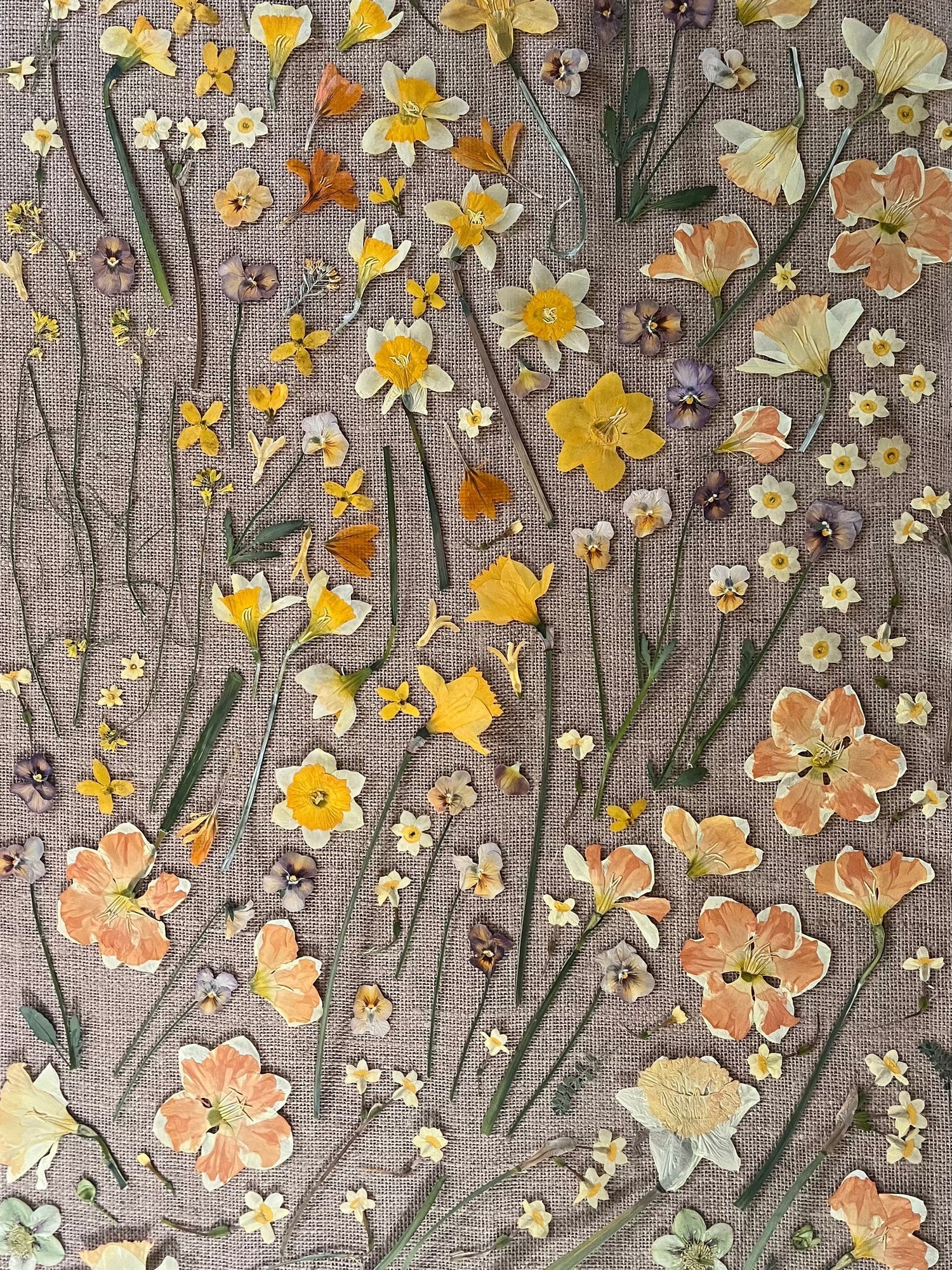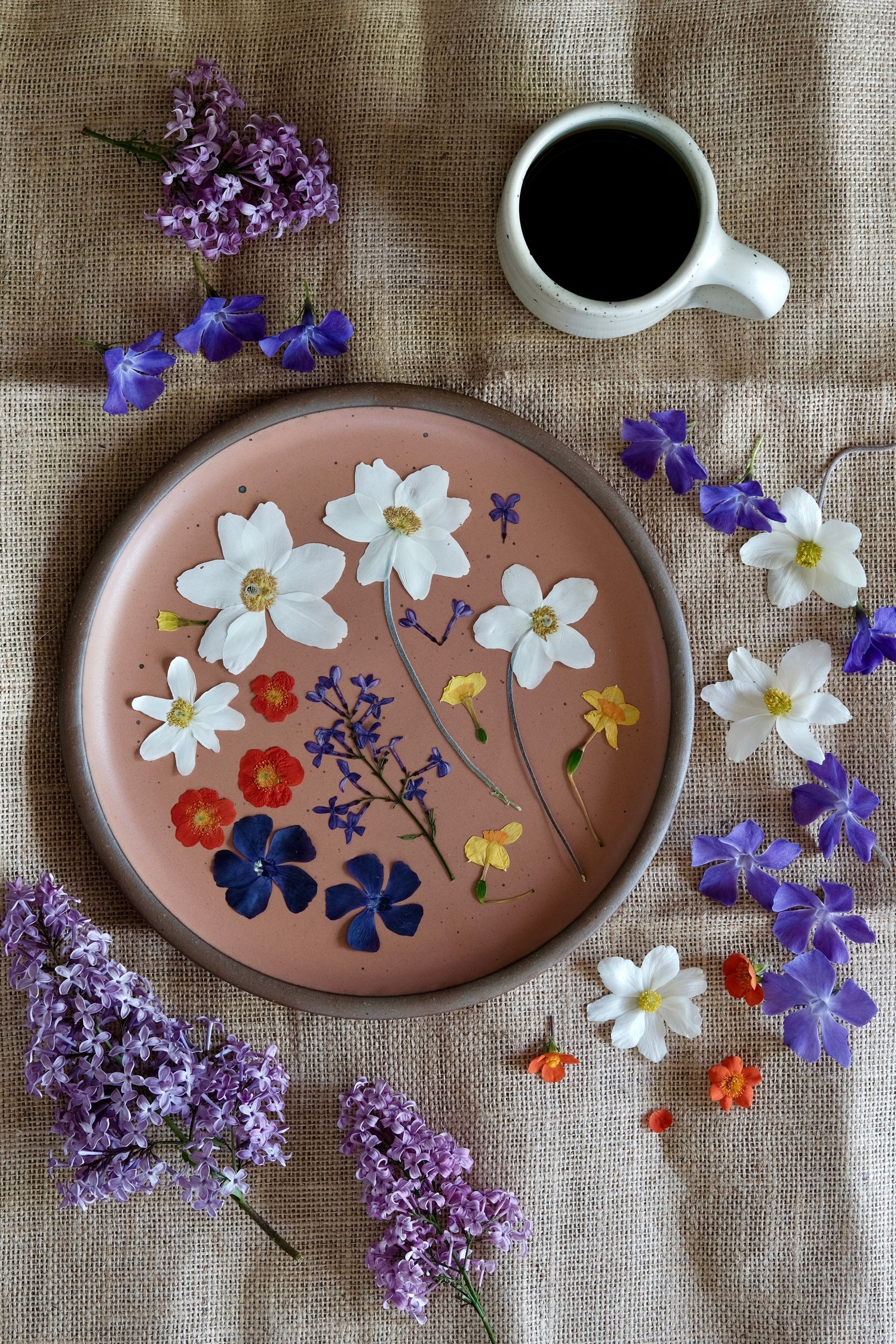
Before you dive into this blog post, we do have a course on how we press our flowers if you want a consolidated, more in-depth lesson on how to press flowers.
DAFFODIL
Admittedly, when we first started pressing flowers, we had trouble with daffodils. We didn't watch over them closely enough and they did brown while in the press. Spring bulbs are naturally moisture-laden which makes sense because their bloom coincides with spring rains.
We tend to press larger daffodils in one of two ways; face down without the stem or spliced with the stem still on. They do come out well if you change paper daily for the first 4 days, then you could potentially skip a day and change every other day for a few rounds, and then they should be good to leave in the press until they are fully dry.
I do find that if you do not splice the stem (cut off the backside of the stem), the stem will tend to turn yellow/brown because of the added layer of moisture. If you do splice the daffodil stem (take half of it off), it usually stays a more vibrant green color, which takes a bit more patience. To achieve flower-pressing perfection, take the time to splice the side of the stem that will be the side facing down, ie, the side you glue down to the paper backing. As you can see, we did not do this in our pressed flower collage in the picture above. The more we press flowers, the more steps we tend to take, and the more things we perfect.
If you look closely at the dwarf daffodils in the collage, you can see that a lot of their stems are brown. We did not splice them. We are fine with this outcome, but next year, we would probably get super tedious and splice off the backside of the stem to avoid browning or we would at least do this for some of them.
We do enjoy pressing dwarf daffodils because they make nice filler pieces in doing a pressed flower collage. They can be kept together as a group on a stem which adds interest and variation to the art piece.

VIOLA/PANSY
These are very straightforward flowers to press because there is only one layer of flowers with very little overlapping of petals. This helps them to dry quickly. We will usually change the paper for 3 or 4 days before letting the flowers dry the rest of the way in the press on their own.
Violas and or pansies can be pressed as easily on the stem or off. Beauty is in the eye of the beholder, so this is a personal choice as to the preferred way to display them in the finished piece. We also find the petals beautiful on their own so sometimes we will press a half page or so as individual petals as fillers for deconstructed pressed flower art pieces.
FORSYTHIA
We haven't yet pressed an entire stem of forsythia. Instead, we pluck the flowers off the stem each morning before they become wilted by the sun. Sometimes they come out well and sometimes they don't. We usually keep the best specimens, meaning the ones that pressed best into a form we enjoy looking at with no weird creases or folds. We will compost the rest.
Forsythia doesn't take long to dry in the press and we will usually only change paper for 2 to 3 days before letting them dry the rest of the time on their own. Forsythia flowers do bruise easily in the press, so if the press is closed too tightly during the first few days of removing their moisture, slight browning/bruising can occur where the petals overlap. This isn't really a big deal, but just something to note.

CROCUS
Crocus are so thin and delicate, which makes them very easy to press and dry with one caveat; they curl up if the paper they are sandwiched between is disturbed before they are dry enough. Thus, our piece of advice when changing paper in the press is to leave the top and bottom sheets they are sandwiched between ALONE until the paper will easily lift from the crocus blossom. We will change the paper for maybe 4 days. They dry paper thin.
HELLEBORE
There is not much that goes into pressing Hellebore. We like them best cut off the stem and pressed face down. We do love splicing and pressing the buds for added interest. Changing the paper for 4 ish days in a row will usually suffice. There are no major problems to note when pressing Hellebore.
There are so many different kinds of hellebore and this has been a good reminder to place an order for a plethora of hellebore root crowns. They are not a bulb but a perennial flower that spreads by rhizomes.

Spring is coming to an end and we will order new flowers to plant while they are fresh in our minds. We don't think a property can have too many flowers.




